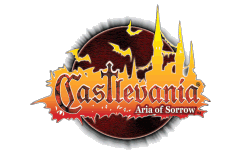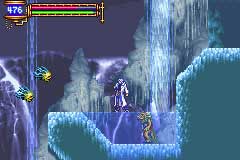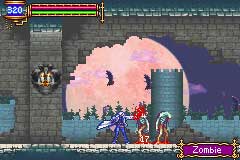|
|

|
BATTLE SYSTEM
|

|
INTERACTION
|

|
ORIGINALITY
|

|
STORY
|

|
MUSIC & SOUND
|

|
VISUALS
|

|
CHALLENGE
|
Moderate
|
COMPLETION TIME
|
3
|
|
OVERALL
4.5/5
|
Rating definitions
|
|
|
Konami did the Gameboy Advance wonders with the spectacular Castlevania: Circle of the Moon, which was a worthy successor to Symphony of the Night. Harmony of Dissonance was fun to play, yet lacked the proper, superb gameplay balance found in the previous two Castlevanias. Aria of Sorrow arrives as the third in a trilogy of Gameboy Castlevania games, bringing us the ultimate version of Castlevania on the GBA, nearing the high bar of excellence set by SotN.
AoS brings back the classic map setup, used in the last 3 Castlevanias and pioneered in Super Metroid, where parts of the game world open up and be accessible as you receive new abilities. In essence, this game is very much an action exploration game. While exploring the castle you defeat enemies with your weapon of choice, along with the protection and bonuses of armor and items equipped. To assist you with your mortal arsenal, you are endured the powers of the ďsoul system,Ē where when the main character, Soma, kills an enemy, he has the chance to obtain its soul, which contains a certain magic power. Itís such a pleasure to see this magic system, similar to the card system in CotM, return, as it allows for a great deal of depth in dealing with the heathens of Draculaís Castle. You can experiment with the different magic setups, as there are many different types of powers, some that are passive and others that incredibly destructive. This sort of customization gives a great sense of freedom in determining the best way to defeat a boss, or get through an infested room. Leveling up with experience points return to the game, which of course gives an incentive to tackling some of the harder creatures rather than avoiding them. Having the option to level up is another weapon up your arsenal. The difficulty is increased from HoD, but not quite as hard as the ever so challenging CotM, nor SotN. Some bosses you will die repeatedly from, but only in a few rooms will you have trouble traversing through, if you are being careless.
 What a surreal setting.
What a surreal setting.
|
|
Hidden rooms return as well, though not as cleverly disguised as CotM, they still further the concept of exploration, providing the player with valuable items, increasing the HP and MP. And there is always the challenge of getting the perfect, 100 perecent rooms explored. Through out all this exploration, you visit areas with beautiful, imposing gothic architecture, just as a Dracula would have it. In fact, some areas are grand and breathtaking. The high towers have an impressive sense of scale, there are cave labyrinths that are eerily colored as if reminding you of an impending apocalypse, a mysterious underworld exists, and many other places awaits exploration. Truth is, for the most part, the graphics are very impressive, right up top there with the best of the GBA games. This along with the music helps provide an amazing atmosphere that most portable games canít accomplish. The music is quite amazing and catchy, with quite a few being gothic influenced, while others are neo-classical, and some even have a dance/techno groove! The variety and quality is quite amazing, and I would not expect any better from the music composer of SotN. Itís also a great benefit that the programmers improved the music quality up from the NES quality in HoD, up to SNES quality sound. Itís truly a joy to experience graphics and sound this good, bringing in quite a feast for the senses.
This game isnít any longer than the other Castlevanias, but it does hit the soft spot of 10-12 hours if you go out of your way to search for more items and secret areas. Multiple endings also play a factor, and when you beat the game, you do get some interesting secrets unlocked. Such as you can play the game again with a different character with different abilities, or you can challenge yourself in the boss rush mode. There is some re-playability if you are into that.
 The moon will always be there, untill you turn off your Gameboy.
The moon will always be there, untill you turn off your Gameboy.
|
|
The biggest improvement in this game is how the story is interwoven into the game. AoS happens to be set in the future, and even though the basic gameplay setting still resides in a gothic castle, this provides the basis for all sorts creative plot possibilities. Thankfully, the scriptwriter takes advantage of this, and provides a sort of compelling story of intrigue. There are even some crafty plot twists towards the second half, as you deal with all sorts of characters of mystery that are introduced and that you interact with. Now granted, there could be more character interaction or character development, but this is the best story out of all of the Castlevanias, providing an incentive to progress through the game, similar to that of a pure console RPG story-line (although with not nearly as much dialouge as one). The only problem I have is that I wish there was more interaction with the environment, perhaps something more akin to a PC adventure game or at least like a Resident Evil game. Oh yeah, and just make sure to get the good ending. Search for a FAQ if you donít know how.
This game provides an experience just as addictive as the previous Castlevanias, along with the bonuses of a great story-line and beautiful graphics and music. No Castlevania fan should do with out this, and newcomers to the Castlevania series could start out with this one. This is arguably the best Castlevania out right now. If you were burned out by the more generic Harmony of Dissonance, or disappointed in how straightforward Lament of Innocence was, this perhaps may woe you back to the series.
Review Archives
|









